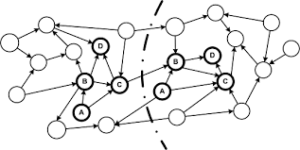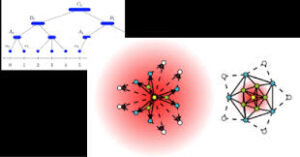Graph Mining: Concepts, Techniques, and Applications 
Graph mining is an interdisciplinary field that combines concepts from graph theory, data mining, and machine learning to extract meaningful patterns and insights from graph-structured data. Graphs are versatile data structures used to model relationships and interactions in various domains, such as social networks, biological networks, recommendation systems, and more. This essay delves into the fundamental concepts of graph mining, its key techniques, challenges, applications, and future trends.
Understanding Graphs
A graph GGG is defined as a pair (V,E)(V, E)(V,E), where VVV is a set of vertices (or nodes) and EEE is a set of edges that connect pairs of vertices. Graphs can be categorized into different types:
- Undirected Graphs:Edges have no direction, meaning the relationship between nodes is mutual.
- Directed Graphs (Digraphs):Edges have a direction, representing one-way relationships.
- Weighted Graphs:Edges carry weights that can represent the strength or capacity of the connection.
- Bipartite Graphs:The vertex set can be divided into two disjoint sets such that no two graph vertices within the same set are adjacent.
Graph mining seeks to uncover patterns, structures, and insights from such data representations.
Key Concepts in Graph Mining
- Graph Representation
Various ways exist to represent graphs for analysis:
- Adjacency Matrix:A square matrix used to represent a finite graph, where the entry at row iii and column jjj indicates the presence (or absence) of an edge between vertices iii and jjj.
- Adjacency List:A collection of lists, where each list corresponds to a vertex and contains the list of its adjacent vertices.
- Edge List:A simple list of all edges in the graph, where each edge is represented as a pair (or tuple) of vertices.
- Subgraph Mining
Subgraph mining involves discovering frequent or significant subgraphs within a larger graph. This process is essential in various applications, such as identifying common motifs in biological networks or detecting communities in social networks.
- Community Detection

Community detection aims to identify clusters or groups of vertices within a graph that are more densely connected to each other than to the rest of the graph. Techniques for community detection include:
- Modularity Optimization:Measures the density of connections within communities compared to connections between communities.
- Label Propagation:An algorithm that spreads labels throughout the graph, allowing nodes to acquire the labels of their neighbors iteratively.
- Graph Classification
Graph classification involves assigning a label to an entire graph based on its structural properties. This is useful in applications such as cheminformatics, where molecules are represented as graphs, and classification can predict their properties.
- Graph Clustering
Graph clustering groups vertices into clusters, where vertices within the same cluster are more similar to each other than to those in other clusters. Clustering algorithms for graphs include spectral clustering and k-means adapted for graph structures.
- Graph Neural Networks (GNNs)
Graph Neural Networks are a class of deep learning methods designed to process graph-structured data. GNNs leverage the connections between nodes to learn representations that capture the graph’s structural information, enabling tasks like node classification and link prediction.
Techniques in Graph Mining
- Data Preprocessing
Before applying mining techniques, graph data often requires preprocessing to ensure quality and relevancy:
- Noise Reduction:Removing irrelevant or redundant data to enhance the quality of the analysis.
- Normalization:Adjusting the graph structure to account for scale or importance, especially in weighted graphs.
- Feature Extraction:Deriving features from graph structures that can be used for machine learning tasks, such as centrality measures (degree, betweenness, closeness) or graph embeddings.
- Graph Mining Algorithms
Several algorithms are central to graph mining:
- Breadth-First Search (BFS) and Depth-First Search (DFS):Fundamental algorithms for exploring graph structures, essential for traversing and analyzing graphs.
- Frequent Subgraph Mining Algorithms:Such as the gSpan and FSG algorithms, used to find frequent subgraphs in large datasets.
- Graph Traversal Algorithms:Algorithms like Dijkstra’s and A* for shortest path finding and optimal routing in weighted graphs.
- Machine Learning Approaches
Machine learning techniques are increasingly applied in graph mining:
- Graph Representation Learning:Methods like Node2Vec and DeepWalk learn low-dimensional embeddings of graph nodes, preserving their structural relationships.
- Supervised and Unsupervised Learning:Graph data can be used in traditional supervised learning frameworks for tasks like classification and regression or in unsupervised settings for clustering and anomaly detection.
Applications of Graph Mining
Graph mining has a wide range of applications across various domains:
- Social Network Analysis

In social networks, graphs represent individuals (nodes) and their relationships (edges). Graph mining techniques can uncover:
- Influencer Detection:Identifying key individuals who have a significant impact on their networks.
- Community Detection:Recognizing groups with common interests or affiliations.
- Biological Network Analysis
Graphs can represent biological networks, such as protein-protein interaction networks:
- Motif Discovery:Finding recurring patterns (motifs) that indicate functional interactions between proteins.
- Pathway Analysis:Understanding metabolic or signaling pathways by analyzing the connectivity of various biological entities.
- Recommendation Systems
Graph mining is crucial in developing recommendation systems, where products or users are represented as nodes, and their interactions are edges. Techniques can uncover:
- Collaborative Filtering:Leveraging user-item graphs to recommend products based on user similarity.
- Content-Based Recommendations:Analyzing the relationships between items based on user preferences and item features.
- Fraud Detection
In financial networks, graphs can represent transactions. Graph mining can detect anomalies indicating fraudulent behavior:
- Link Prediction:Identifying potential fraudulent connections between entities based on historical transaction data.
- Anomaly Detection:Recognizing unusual patterns or outlier transactions that deviate from typical behavior.
- Knowledge Graphs
Knowledge graphs represent entities and their relationships, enabling applications in natural language processing and semantic search. Graph mining can help:
- Entity Linking:Connecting entities based on relationships to improve information retrieval.
- Relationship Extraction:Identifying and extracting relationships between entities to enhance knowledge representation.
Challenges in Graph Mining
Despite its potential, graph mining faces several challenges:
- Scalability
As the size of graphs increases, traditional algorithms may struggle to handle the computational demands. Efficient algorithms that can scale to large datasets are crucial.
- Dynamic Graphs
Many real-world graphs are dynamic, with vertices and edges constantly changing. Developing algorithms that can adapt to these changes in real time is a significant challenge.
- Noise and Uncertainty

Graph data often contains noise and uncertainty, which can lead to incorrect conclusions. Robust techniques that can handle imperfect data are essential for reliable mining results.
- Interpretability
Interpreting the results of graph mining algorithms, especially those involving machine learning, can be complex. Ensuring that the insights generated are understandable and actionable is vital.
Future Trends in Graph Mining
The field of graph mining is rapidly evolving, with several trends likely to shape its future:
- Integration with Deep Learning
The incorporation of deep learning techniques into graph mining is gaining traction, particularly through Graph Neural Networks (GNNs), which enable the processing of graph-structured data with greater accuracy and efficiency.
- Increased Focus on Explainability
As graph mining techniques become more complex, the need for interpretability and explainability will grow. Developing methods to provide insights into how decisions are made will be crucial for trust and adoption.
- Applications in Emerging Domains
Graph mining is poised to expand into new domains such as smart cities, where urban systems can be modeled as graphs, and the Internet of Things (IoT), where devices and their interactions form complex networks.
- Advanced Privacy-Preserving Techniques
As data privacy concerns grow, developing privacy-preserving graph mining techniques will be essential to ensure compliance with regulations while still enabling meaningful insights from graph data.
Conclusion
Graph mining is a dynamic and multifaceted field that plays a critical role in extracting insights from complex data structures. By leveraging various techniques and approaches, graph mining enables the discovery of meaningful patterns and relationships in diverse applications, from social networks to biological systems. However, challenges related to scalability, noise, and interpretability persist, necessitating ongoing research and innovation. As the field evolves, the integration of graph mining with advanced technologies, such as deep learning and privacy-preserving methods, will enhance its relevance and applicability in an increasingly interconnected world. Through continued exploration and development, graph mining will remain a vital tool for understanding the complexities of relationships and interactions in various domains.

